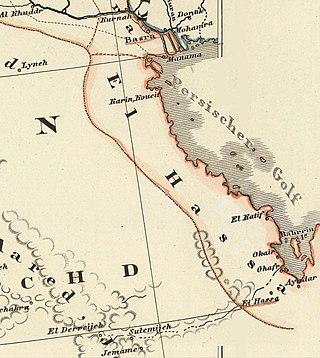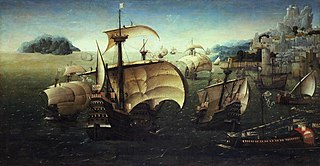
The Battle of Diu was a naval battle fought on 3 February 1509 in the Arabian Sea, in the port of Diu, India, between the Portuguese Empire and a joint fleet of the Sultan of Gujarat, the Mamlûk Burji Sultanate of Egypt and the Zamorin of Calicut.
The Ottoman–Portuguese or the Turco-Portuguese confrontations refers to a series of different military encounters between the Portuguese Empire and the Ottoman Empire, or between other European powers and the Ottoman Empire in which relevant Portuguese military forces participated. Some of these conflicts were brief, while others lasted for many years. Most of these conflicts took place in the Indian Ocean, in the process of the expansion of the Portuguese Empire, but also in the Red Sea. These conflicts also involved regional powers, after 1538 the Adal Sultanate, with the aid of the Ottoman Empire, fought against the Ethiopian Empire, which was supported by the Portuguese, under the command of Cristóvão da Gama, the son of the famous explorer Vasco da Gama. This war is known as the Ethiopian–Adal war.

The Ottoman-Portuguese conflicts were a period of conflict during the Ottoman–Portuguese confrontations and series of armed military encounters between the Portuguese Empire and the Ottoman Empire along with regional allies in and along the Indian Ocean, Persian Gulf, and Red Sea.

The Ottoman–Portuguese Conflicts (1586–1589) were armed military engagements which took place between the Portuguese Empire and the Ottoman Empire along the coast of eastern Africa.

The siege of Diu occurred when an army of the Sultanate of Gujarat under Khadjar Safar, aided by forces of the Ottoman Empire, attempted to capture the city of Diu in 1538, then held by the Portuguese. The Portuguese successfully resisted the four months long siege. It is part of the Ottoman-Portuguese war.

The Portuguese conquest of Hormuz in 1507 occurred when the Portuguese Afonso de Albuquerque attacked Hormuz Island to establish the Fortress of Hormuz. This conquest gave the Portuguese full control of the trade between India and Europe passing through the Persian Gulf.

The Portuguese–Safavid wars were a series of wars between the Portuguese Empire and Safavid Iran from 1507 to 1625. The Portuguese were also supported by Kingdom of Hormuz, its vassal, and Safavids had the help of the Kingdom of England on the other side.

The capture of Muscat occurred in 1552, when an Ottoman fleet under Piri Reis attacked Old Muscat, in modern Oman, and plundered the town from the Portuguese. These events followed the important Ottoman defeat in the third siege of Diu in 1546, which put a stop to their attempts in India, but also the successful capture of Aden in 1548, which allowed the Ottomans to resist the Portuguese in the northwestern part of the Indian Ocean.

The Ottoman campaign against Hormuz took place in 1552–1554. An Ottoman fleet led by Admiral Piri Reis and Seydi Ali Reis was dispatched from the Ottoman harbour of Suez to eliminate the Portuguese presence from the northwestern part of the Indian Ocean, and especially their fortress at Hormuz Island.

The Battle of the Gulf of Oman was a naval battle between a large Portuguese armada under Dom Fernando de Meneses and the Ottoman Indian fleet under Seydi Ali Reis. The campaign was a catastrophic failure for the Ottomans who lost all of their ships.

Lahsa Eyalet was an eyalet of the Ottoman Empire. The territory of the former eyalet is now part of Saudi Arabia, Kuwait, and Qatar. Al-Ahsa and Qatif were the main cities of the eyalet, and it was named after the former.

The War of the League of the Indies was a military conflict in which a pan-Asian alliance formed primarily by the Sultanate of Bijapur, the Sultanate of Ahmadnagar, the Kingdom of Calicut, and the Sultanate of Aceh, referred to by the Portuguese historian António Pinto Pereira as the "league of kings of India", "the confederated kings", or simply "the league", attempted to overturn Portuguese presence in the Indian Ocean. This was attempted through a combined assault on some of the main possessions of the Portuguese State of India: Malacca, Chaul, Chale fort, and the capital of the maritime empire in Asia, Goa.

The Battle of the Strait of Hormuz was fought in August 1553 between an Ottoman fleet, commanded by Admiral Murat Reis, against a Portuguese fleet of Dom Diogo de Noronha. The Turks were forced to retreat after clashing with the Portuguese.

The battle of Hormuz or the battle of the Persian Gulf on 11–12 February 1625 was "perhaps the largest naval battle ever fought in the Persian Gulf". It pitted a Portuguese force against a combined force of the Dutch East India Company (VOC) and English East India Company (EIC). Although the battle was a draw, the result was the loss of Portuguese influence in the Gulf.
Dom Diogo de Noronha was an important Portuguese military and a naval officer from the 16th century. He served in Portuguese Asia under viceroys Dom Afonso de Noronha (1550-1554), Dom Pedro Mascarenhas (1554-1555), governor Francisco Barreto (1555-1558) and viceroy Dom Constantino de Braganza (1558-1561). He is mostly recorded as the first Portuguese captain of Daman, India and one of the fathers of the Portuguese Northern Province.

The battle of al-Shihr was a military confrontation in 1548 between the Portuguese alongside Sa'd bin Afrar, the ruler of Mahra Sultanate and Kathiri Sultanate who had captured al-Mahrah from Sa'd The Portuguese successfully captured the fort near al-Shihr from the Kathiris.
The siege of Qatif was a military confrontation between the Portuguese Empire and the Ottoman Empire at Qatif in 1551. The Portuguese, together with their Hormuzi vassals successfully sieged, captured and demolished the fort captured from the Ottomans.

The Battle of El Tor was a military engagement that took place in 1541, between Portuguese forces under the command of the Governor of India Dom Estevão da Gama and those of the Ottoman Empire then in the city of El Tor, on the Sinai Peninsula. The Turks were driven from the city, but at the request of Christian monks from the Monastery of Saint Catherine the Portuguese spared the city from being plundered, and celebrated a mass and a knighting ceremony therein.

Gujarati–Portuguese conflicts refers to the armed engagements between the Portuguese Empire and the Sultanate of Gujarat, in India, that took place from 1508 until Gujarat was annexed by the Mughal Empire in 1573.















